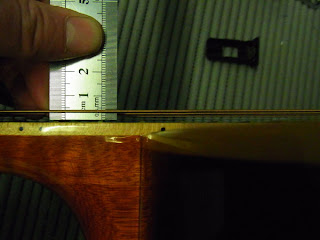Guitar maintenance
Author: Ian Bush
How to stop strings snapping at the nut so often:
1. Change your strings to a larger gauge (eg. from ELST 9-42's to ELST 9-46's) - We find that by using a slightly thicker string these last a lot longer
2. Grab a pencil; rub the pencil graphite in the slot
Why do you use a pencil?
If you ever hear your strings creaking, it just means the string is getting caught a little in the nut. Rub a little pencil into the slot and the graphite from your pencil acts as a lubricant and lets the string flow a bit easier. It does leave a little mess but it will make your guitar tune a lot easier. You can also get specially designed nut lubricant or some people even use Vaseline (but only a touch).
How to Solve tuning problems on a Steel string guitar:
There are 5 main causes of tuning problems on a steel string guitar.
1. Machine heads
2. Too little string on the machine head
3. Too Much string on the machine head – the ideal here is 3-4 turns
4. Gaps in the string on the machine head (this is a common issue and so easily solved)
5. The ball end of the string is not sitting on the sound board (or top of the
guitar)
So how do we solve the 4th and 5th issues it’s so simple ... Pull on your strings
Let me explain.
Pulling on your strings helps remove the slack at the machine head , It also helps settle the string into the top of the guitar.
Go and grab your guitar now. Play a note - Pull the string (give it a good go , if you’re worried use the low E as there is no way you can break this string) play the same note again. If the pitch is the same your guitar was fine, but if it changed you had slack in your system. This simple secret will keep you in tune for much, much longer.
Now try another test. Gently pull your bridge pin out (but only half way or the string may come out – be careful here and protect your eyes) if you can do that without the note changing pitch then you were setup correctly - you should be able to move the bridge pin and have almost no effect on the pitch of the string.
How do I stop the bridge pin issue happening the next time I change my string’s ?
Put a bend in the end of your string 1-2cm from the ball, as you push the bridge pin in the guitar pull back on the string so it’s sitting right on the sound board (as an added benefit your tone will also be much better)
How to set up a guitar properly:
Check out our blog post for an easy way to adjust your truss rod.
Firstly, you need to tune your guitar to a perfect tune. you will need an electronic tuner

As you can see down here, as you look down the fingerboard ( the wood underneath the strings ) that this guitar has a curve away from the string. When it is curved away from the string you need to tighten the neck, so that it is straight. if the neck is curved towards the strings, you need to loosen the neck.
Now to adjust your neck, you will need an Allen key (which normally comes supplied with your guitar). To tighten (which will straighten the neck) you turn the key clockwise as you are looking at it. But be careful ! Don't over tighten or force it as you could damage your guitar if your not careful. A truss rod can often be turned completely off, so it feels like its doing nothing, but once it has started to adjust, a 1/4 turn is usually enough to make it straight again.
Now you need to change the action height

Here you can see how we measure the action height of a guitar. To do this properly you need a metal ruler that ends exactly at zero, and preferably a wide one. The small rulers are OK, but a wide ruler is much easier to make sure you have it nice and straight (and if its not straight your measurement will be wrong). action height should be 2.6 mm for acoustic guitar, 1.8 for electric, and 2.0mm for bass. as you can see in the photo, our action height is about 2.6-2.7mm.
To lower the action heigh on an ST, TC, Or PB, simply take the smaller allen key supplied, and tighten or loosen the allen key screws on the bridge ( toighten to lower, loosen to raise.)
On a LP or SG guitar, take a flat head screwdriver, and adjust the bridge screws. again, tighten to lower, loosen to heighten
you cant really adjust an acoustic, so if there is a problem with the action on an acoustic, give us a call or an email.
